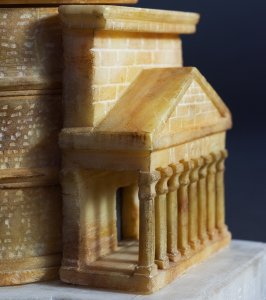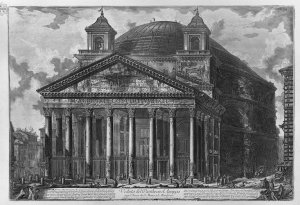Pantheon, Rome
alabaster
3-1/2″ h., 1870’s
3500
When the present version of this signal monument was dedicated in 126 CE (there had been two earlier Panthei, both destroyed by fire), its self-supporting concrete dome, an engineering marvel, was the largest in the world. 1,896 years later, what is the world’s largest self-supported dome? The Pantheon. Less enduring were the materials used in the production of tourists’ models of the ancient temple. The earliest of these were cast in bronze, c. 1870.

This carefully rendered, souvenir likeness of the Pantheon is without bell towers, and our first instinct would be to date it after 1883, or after 1892, or after the 1870’s, depending upon which history we believe. However, this model, owing to its materials – color-tinted alabaster from Volterra – almost certainly dates to the 1870’s. We’ve not seen any 19th century stone model of the building including the twin towers (there are examples in bronze); perhaps they proved difficult to carve.
Bernini did play a role with the Pantheon, though, directing the removal of ancient bronze coffering from the underside of the porch for his baldacchino at St. Peter’s. About this vandalism, Bernini apologists demur. Rome’s greatest baroque designer also employed material from the Colosseum, a building operated by the Papacy as a quarry (for a thousand years!), The immense structure we see today is barely one-third its original size. Where did Bernini obtain the travertine for his colonnade at St. Peter’s? Don’t ask.


